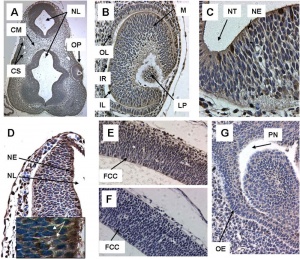Williams Syndrome
| Embryology - 28 Apr 2024 |
|---|
| Google Translate - select your language from the list shown below (this will open a new external page) |
|
العربية | català | 中文 | 中國傳統的 | français | Deutsche | עִברִית | हिंदी | bahasa Indonesia | italiano | 日本語 | 한국어 | မြန်မာ | Pilipino | Polskie | português | ਪੰਜਾਬੀ ਦੇ | Română | русский | Español | Swahili | Svensk | ไทย | Türkçe | اردو | ייִדיש | Tiếng Việt These external translations are automated and may not be accurate. (More? About Translations) |
ICD-11 - Williams-Beuren syndrome
|
|---|
Introduction
Williams syndrome (WS, Monosomy 7q11.23, 7q11.23 deletion) is characterized by cardiovascular disease (elastin arteriopathy, peripheral pulmonary stenosis, supravalvular aortic stenosis, hypertension), distinctive facies, connective tissue abnormalities, mental retardation (usually mild), a specific cognitive profile, unique personality characteristics, growth abnormalities, and endocrine abnormalities (hypercalcemia, hypercalciuria, hypothyroidism, and early puberty).
- Links: 2011 Student Project
Some Recent Findings
|
| More recent papers |
|---|
|
This table allows an automated computer search of the external PubMed database using the listed "Search term" text link.
More? References | Discussion Page | Journal Searches | 2019 References | 2020 References Search term: Williams Syndrome |
General Transcription Factor II-I Repeat Domain-containing Protein 1
GTF2IRD1 Links
- OMIM General Transcription Factor II-I Repeat Domain-containing Protein 1 (GTF2IRD1)
- Mapview GTF2IRD1
- Gene GTF2IRD1
Growth Charts
The following data is from a paper producing a growth reference for British children with Williams syndrome.[3]
Female
- Height chart for females with Williams syndrome
- Weight chart for females with Williams syndrome
- Head circumference chart for females with Williams syndrome
Male
- Height chart for males with Williams syndrome
- Weight chart for males with Williams syndrome
- Head circumference chart for males with Williams syndrome
- Links: Growth Charts
References
- ↑ Gervan P, Gombos F & Kovacs I. (2012). Perceptual learning in Williams syndrome: looking beyond averages. PLoS ONE , 7, e40282. PMID: 22792262 DOI.
- ↑ Palmer SJ, Santucci N, Widagdo J, Bontempo SJ, Taylor KM, Tay ES, Hook J, Lemckert F, Gunning PW & Hardeman EC. (2010). Negative autoregulation of GTF2IRD1 in Williams-Beuren syndrome via a novel DNA binding mechanism. J. Biol. Chem. , 285, 4715-24. PMID: 20007321 DOI.
- ↑ Martin ND, Smith WR, Cole TJ & Preece MA. (2007). New height, weight and head circumference charts for British children with Williams syndrome. Arch. Dis. Child. , 92, 598-601. PMID: 17301110 DOI.
Reviews
Riby DM & Porter MA. (2010). Williams syndrome. Adv Child Dev Behav , 39, 163-209. PMID: 21189808
American Journal of Medical Genetics Part C: Seminars in Medical Genetics Special Issue: Williams Syndrome 15 May 2010
Articles
Morris CA. (2010). Introduction: Williams syndrome. Am J Med Genet C Semin Med Genet , 154C, 203-8. PMID: 20425781 DOI.
Pani AM, Hobart HH, Morris CA, Mervis CB, Bray-Ward P, Kimberley KW, Rios CM, Clark RC, Gulbronson MD, Gowans GC & Gregg RG. (2010). Genome rearrangements detected by SNP microarrays in individuals with intellectual disability referred with possible Williams syndrome. PLoS ONE , 5, e12349. PMID: 20824207 DOI.
Search PubMed
Search Pubmed: Williams Syndrome | GTF2IRD1
External Links
External Links Notice - The dynamic nature of the internet may mean that some of these listed links may no longer function. If the link no longer works search the web with the link text or name. Links to any external commercial sites are provided for information purposes only and should never be considered an endorsement. UNSW Embryology is provided as an educational resource with no clinical information or commercial affiliation.
- PubMed Health Williams Syndrome
- OMIM General Transcription Factor II-I Repeat Domain-containing Protein 1 (GTF2IRD1)
- Williams Syndrome Foundation UK
- Williams Syndrome International contact List
Glossary Links
- Glossary: A | B | C | D | E | F | G | H | I | J | K | L | M | N | O | P | Q | R | S | T | U | V | W | X | Y | Z | Numbers | Symbols | Term Link
Cite this page: Hill, M.A. (2024, April 28) Embryology Williams Syndrome. Retrieved from https://embryology.med.unsw.edu.au/embryology/index.php/Williams_Syndrome
- © Dr Mark Hill 2024, UNSW Embryology ISBN: 978 0 7334 2609 4 - UNSW CRICOS Provider Code No. 00098G

